
Extend the platform,
empower your team.


Salesforce Event Streaming (v2)
Capture Real User Monitoring data via Salesforce Real Time Event Streaming.
Extension- Product information
- Release notes
Overview
The Salesforce Event Streaming extension allows you to monitor the usage of your Salesforce CRM account.
Answer questions like:
- What are the slowest Lightning or Classic pages response times
- Track Session Hijack, Credential Stuffing and Anomaly Events
- Track important permission sets changes
- What files are being uploaded and download? By which users?
- What are the most used reports, who is running them, what queries are being used
- How many users are using the platform currently, what is the user experience
- What are the top API Queries being made
- Where is salesforce being accessed from?
- What is the browser being used?
Get started
Requirements
- A Salesforce account with real time event streaming enabled
- For Username + Password authentication, the username, password and security token
- For Connected App authentication, a Connected App with a pem certificate
- An Environment Activegate
Salesforce Account
- Under
Setup->Event ManagerenableStreaming Datafor the events you want to capture. - Obtain the credentials needed for the extension to connect to Salesforce.
- For Username + Password authentication, check the User and Password Authentication section of this documentation
- For Connected App authentication, check the Connected App Authentication section of this documentation
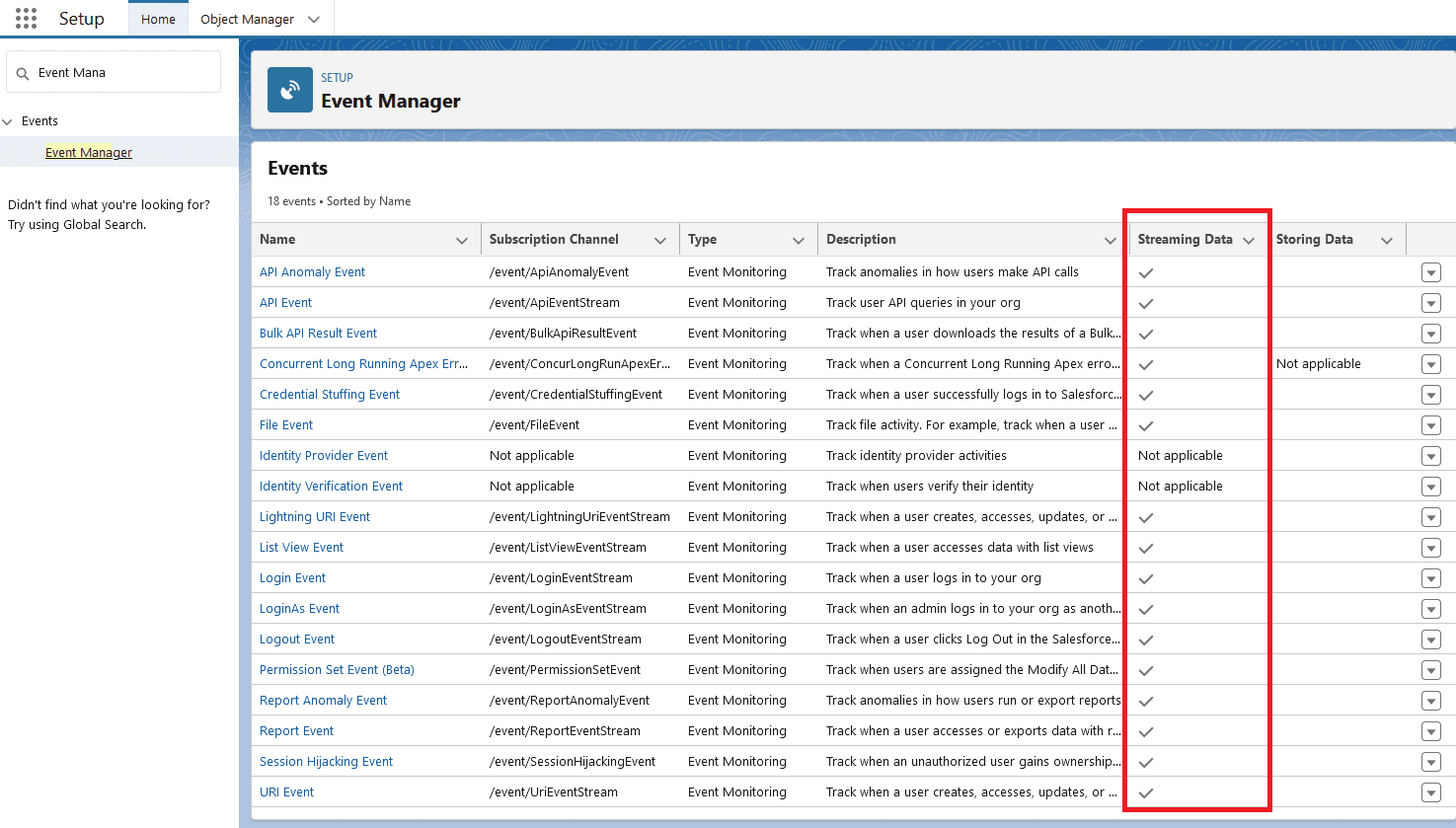
Dynatrace
Create a Custom Application to receive the data:
- Navigate to
Digital Experiences->Custom Applications->Create custom application. - Give it a name and an icon
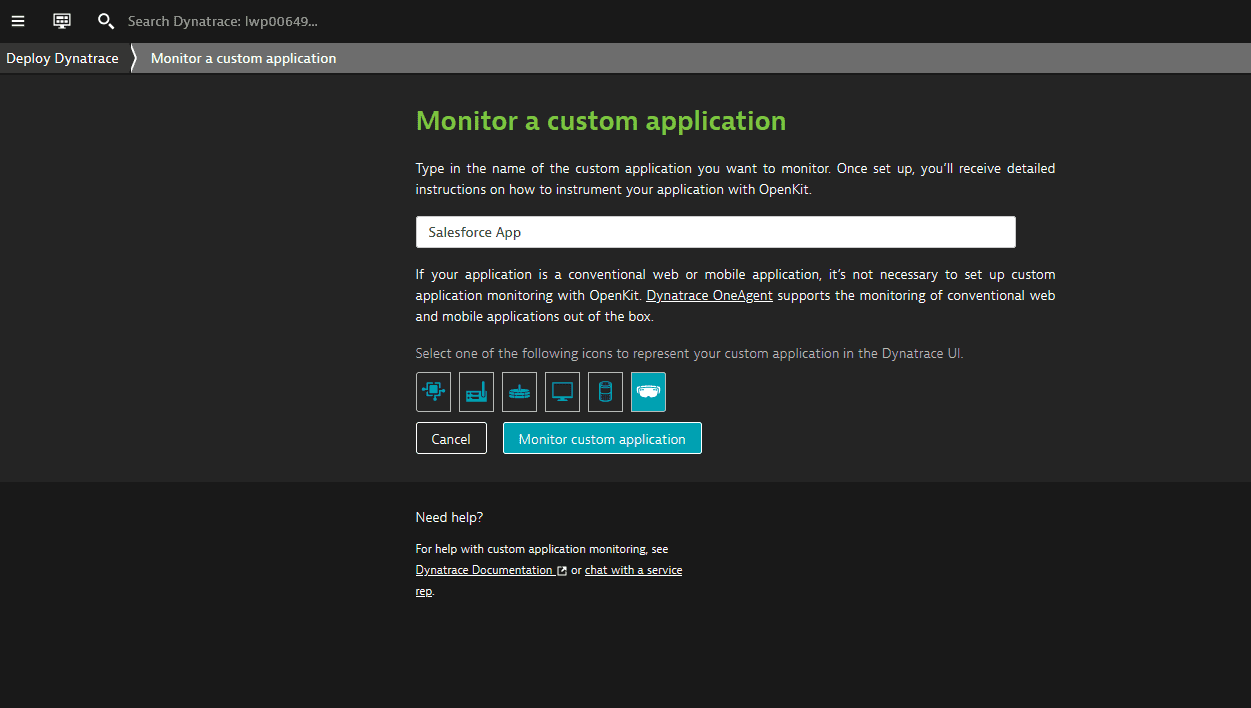
- Under the application settings, navigate to
Instrumentation Wizardand save the Application ID for later
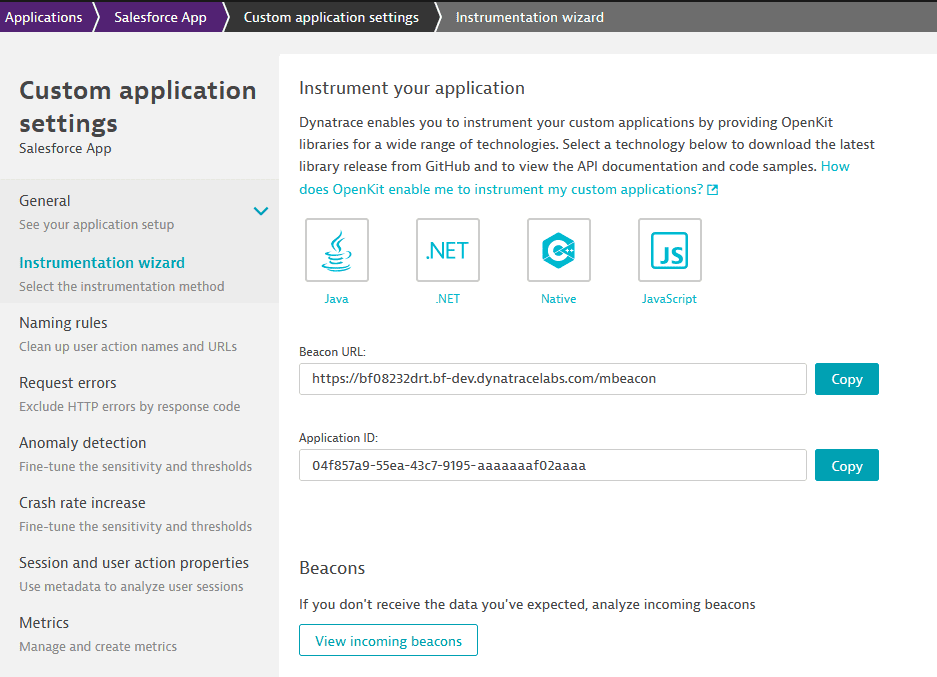
Activate the extension:
- Navigate to the Dynatrace Hub and activate the extension.
- Create a monitoring configuration on the extension page.
- Select an Activegate group.
- One of these servers will need to access the salesforce API, which is on the internet.
- The login URLs are:
https://login.salesforce.comorhttps://test.salesforce.com - The Pub Sub endpoints are:
api.pubsub.salesforce.com:7443orapi.deu.pubsub.salesforce.com:7443 - A proxy can be configured later if necessary.
The parameters for the monitoring configuration are:
| Parameter | Description |
|---|---|
| Endpoint name | A friendly name to identify the endpoint |
| Login URL | Chose from Production or Sandbox |
| Pub/Sub URL | Chose from Global Endpoint or Europe (Frankfurt) Endpoint |
| Reporting Mode | Only OpenKit is supported at this time |
| Custom Application ID | The Dynatrace Custom Application ID for the app you created before |
| Authentication type | Choose from Username and Password or Connected App, see specific documentation below |
| Events filtering | Choose which real time events you'd like to send to Dynatrace, by default all are enabled |
| Usernames Blocklist | Optional list of Usernames to ignore, use this to block automation/api users from reporting |
| Proxy | Optional proxy, in case the Activegate cannot connect to the Salesforce URLs |
The data is sent to the Frontend Application that you created:
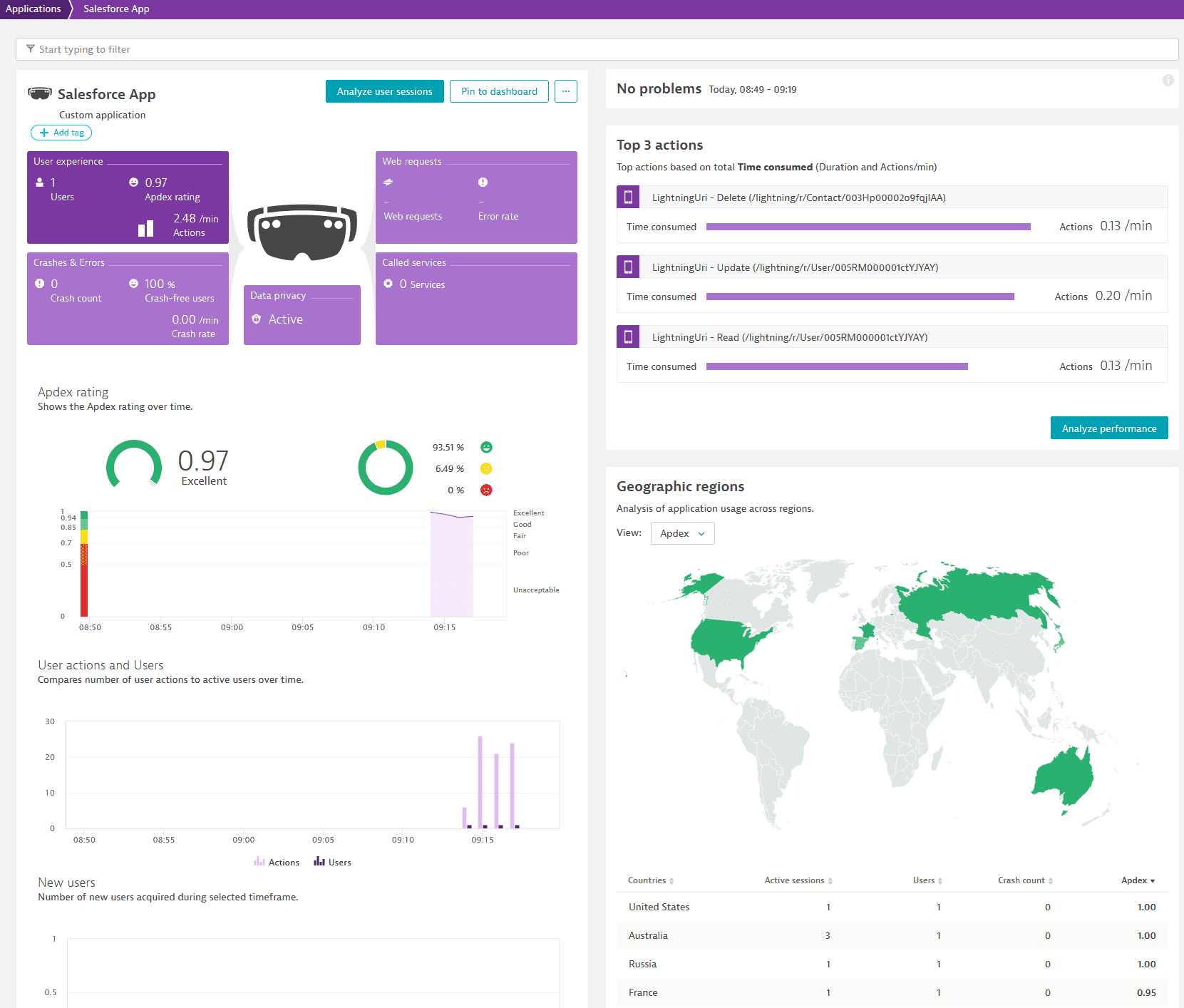
You can drill down to the Sessions:
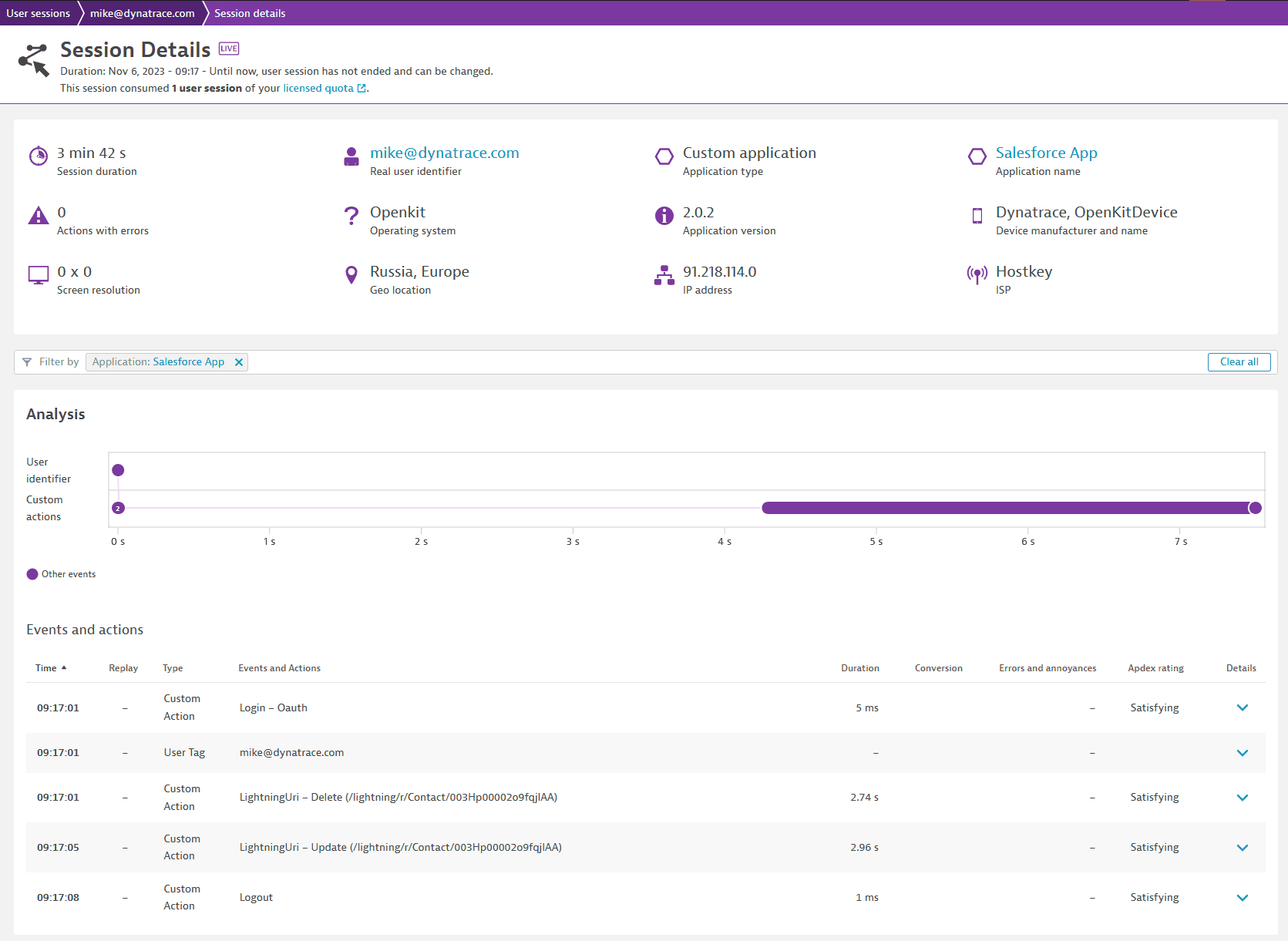
And to the individual properties, by clicking on the User Action > Perform waterfall analysis:
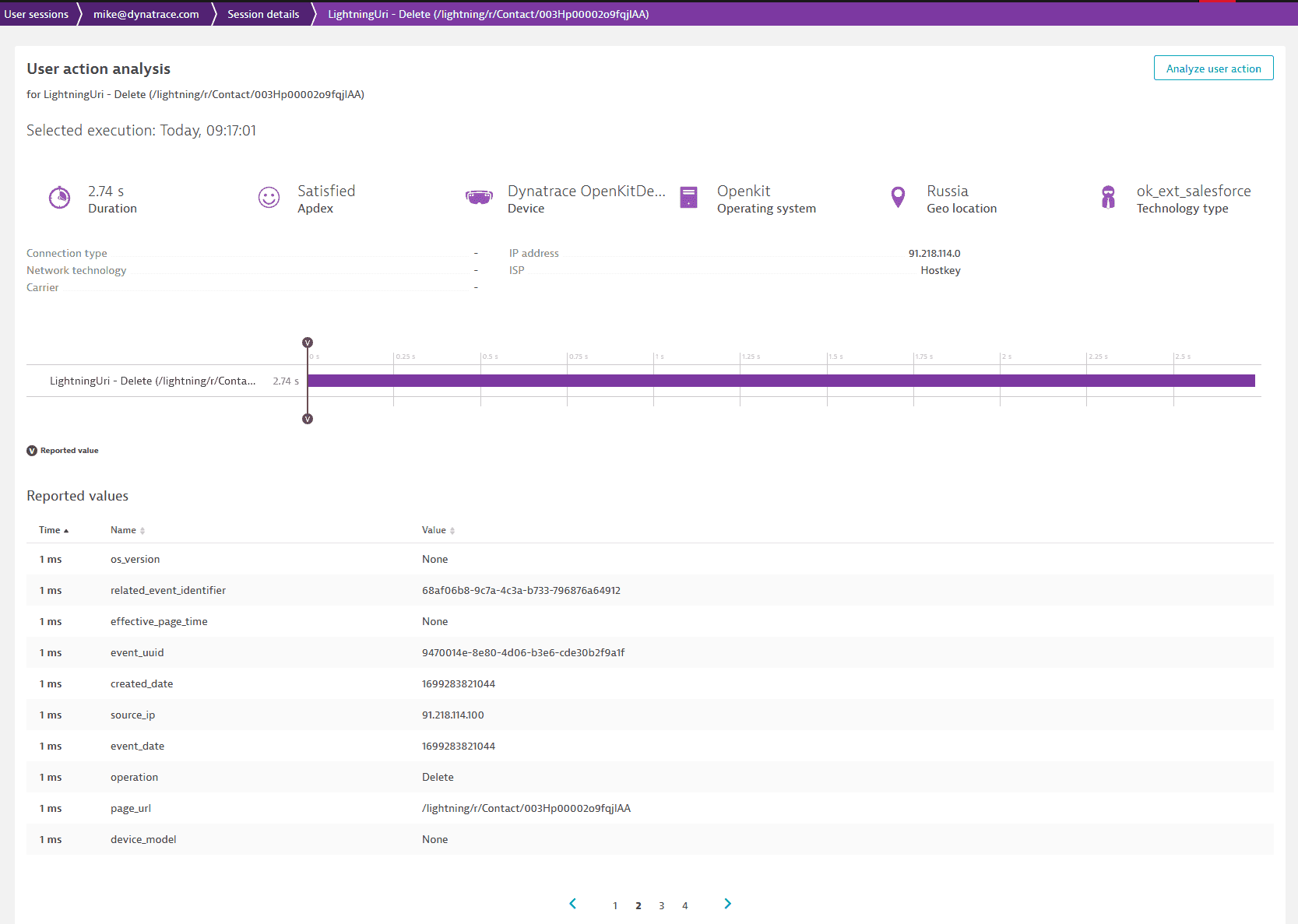 To use these properties in User Sessions Query Language:
To use these properties in User Sessions Query Language:
- Under the application settings, navigate to
Session and user action properties - Create a property. Note: the Name must match exactly the property name as documented in the Salesforce events.
Example: capturing the number of rows for a report:
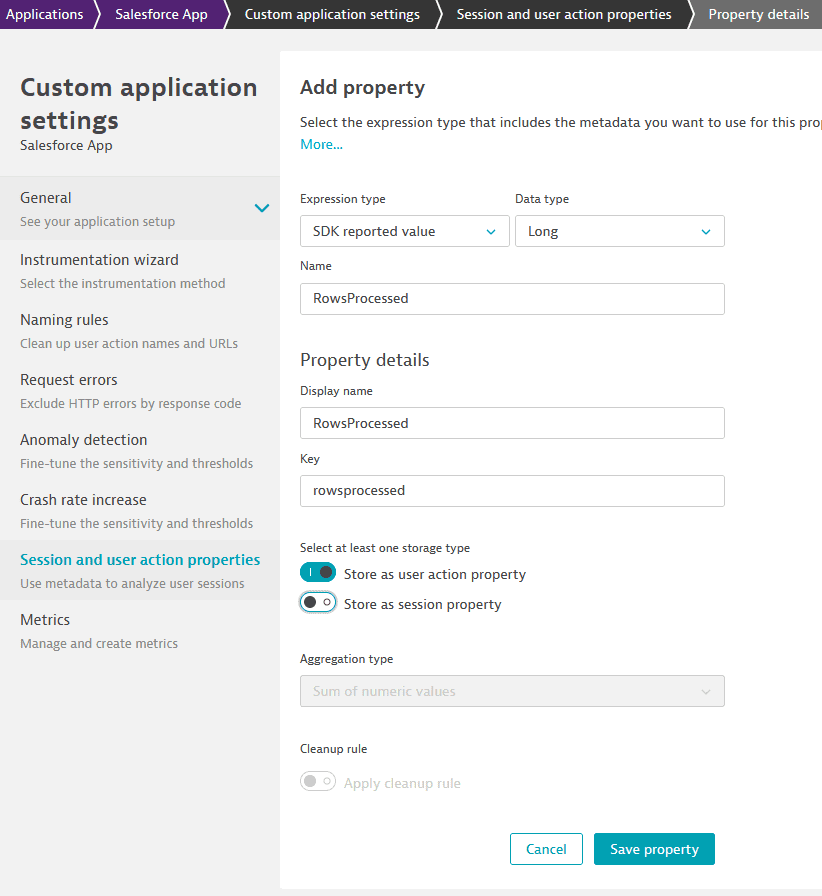
Querying the property:
SELECT useraction.name, SUM(longProperties.rowsprocessed) FROM useraction WHERE useraction.name STARTSWITH "Report" GROUP BY useraction.name
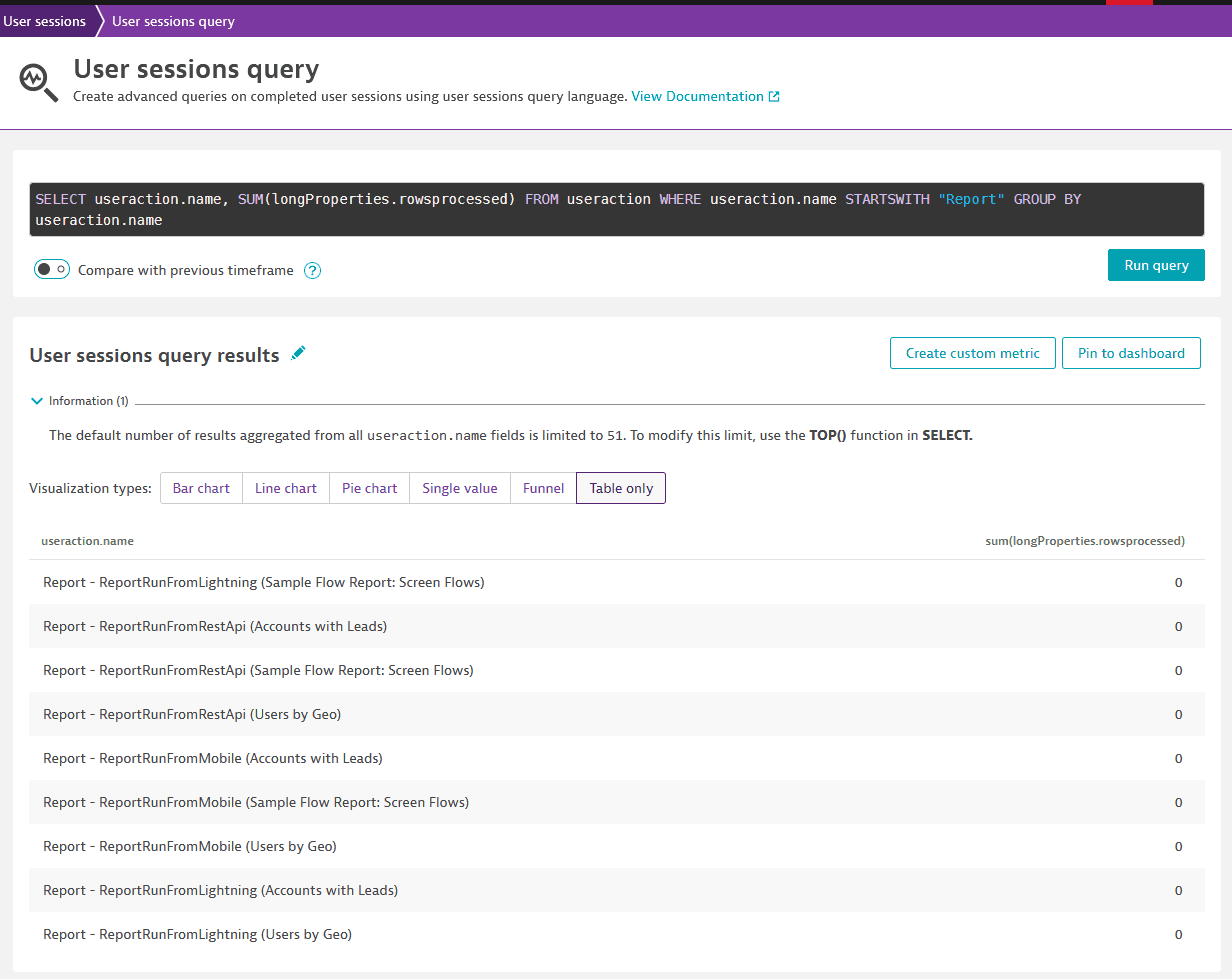
Details
The extension uses the Salesforce Pub/Sub API to listen for Event Streaming Events.
These events are captured and sent as User Actions with all their respective properties sent as Action Properties. The event properties can be seen by
clicking on an User Action > Perform waterfall analysis
A detailed description of every event and their properties can be found on the Salesforce documentation.
The current events being captured are:
- ApiAnomalyEvent - Track anomalies in how users make API calls
- ApiEventStream - Track user API queries in your org
- BulkApiResultEvent - Track when a user downloads the results of a Bulk API request
- ConcurLongRunApexErrEvent - Track when a Concurrent Long Running Apex error has occurred
- CredentialStuffingEvent - Track when a user successfully logs in to Salesforce during an identified credential stuffing attack
- FileEvent - Track file activity. For example, track when a user downloads or previews a file
- LightningUriEventStream - Track when a user creates, accesses, updates, or deletes a record in Salesforce Lightning
- ListViewEventStream - Track when a user accesses data with list views
- LoginAsEventStream - Track when an admin logs in to your org as another user
- LoginEventStream - Track when a user logs in to your org
- LogoutEventStream - Track when a user clicks Log Out in the Salesforce UI
- PermissionSetEvent - Track when users are assigned the Modify All Data or View All Data permission through a permission set
- ReportAnomalyEvent - Track anomalies in how users run or export reports
- ReportEventStream - Track when a user accesses or exports data with reports
- SessionHijackingEvent - Track when an unauthorized user gains ownership of a Salesforce user’s session with a stolen session identifier
- UriEventStream - Track when a user creates, accesses, updates, or deletes a record in Salesforce Classic
User and Password authentication
-
A user with the permissions:
-
General User Permissions
View Real-Time Event Monitoring Data
-
Administrative Permissions
Customize ApplicationView All Data
-
-
The password for the user
-
The security token for the user
Connected App authentication
In this mode the extension connects as a Connected App, this is the recommended method of authentication and no user password is required.
Technically, the app implements the OAuth 2.0 JWT Bearer Flow
Dynatrace will ask for:
- The Consumer Key of the Connected App
- The Private Key of the Connected App
- The Subject of the JWT token, this is the username of a user that is part of a Profile in the Connected App
Requirements
openssl(for generating the certificate, not needed if you already have a certificate and private key)
Note, on Windows if you have git installed you should also have a copy of openssl.
It would be under a directory like C:\Program Files\Git\mingw64\bin depending on your installation.
You can read more about the OAuth 2.0 JWT Bearer Flow here
Certificate
The connected app must have a certificate.
We later authenticate with Salesforce using this certificate's private key
This command generates a certificate and a private key:
openssl req -newkey rsa:2048 -nodes -keyout key.pem -x509 -days 365 -out cert.pem
The cert.pem file will be later added to the Connected App.
The key.pem file will be used by Dynatrace to authenticate with Salesforce.
Create the Connected App
In Salesforce Lightning:
- Go to Setup > Apps > App Manager
- Select New Connected App

Give the app a name and add the contact email. Under API (Enable OAuth Settings):
- Check Enable OAuth Settings
- The Callback URL is not used, you can input
http://localhost - Check Use digital signatures
Upload the cert.pem file generated above under Use digital signatures.
Under Selected OAuth Scopes, Add these scopes:
- Manage use data via APIs (api)
- Perform requests at any time (refresh_token, offline_access)
Leave all other settings as default and click Save.
The Connected App screen should look like this (with your name, email and certificate):

OAuth policy
Now set up the OAuth Policy permitted users.
On the connected app page, select Manage, then Edit Policies.
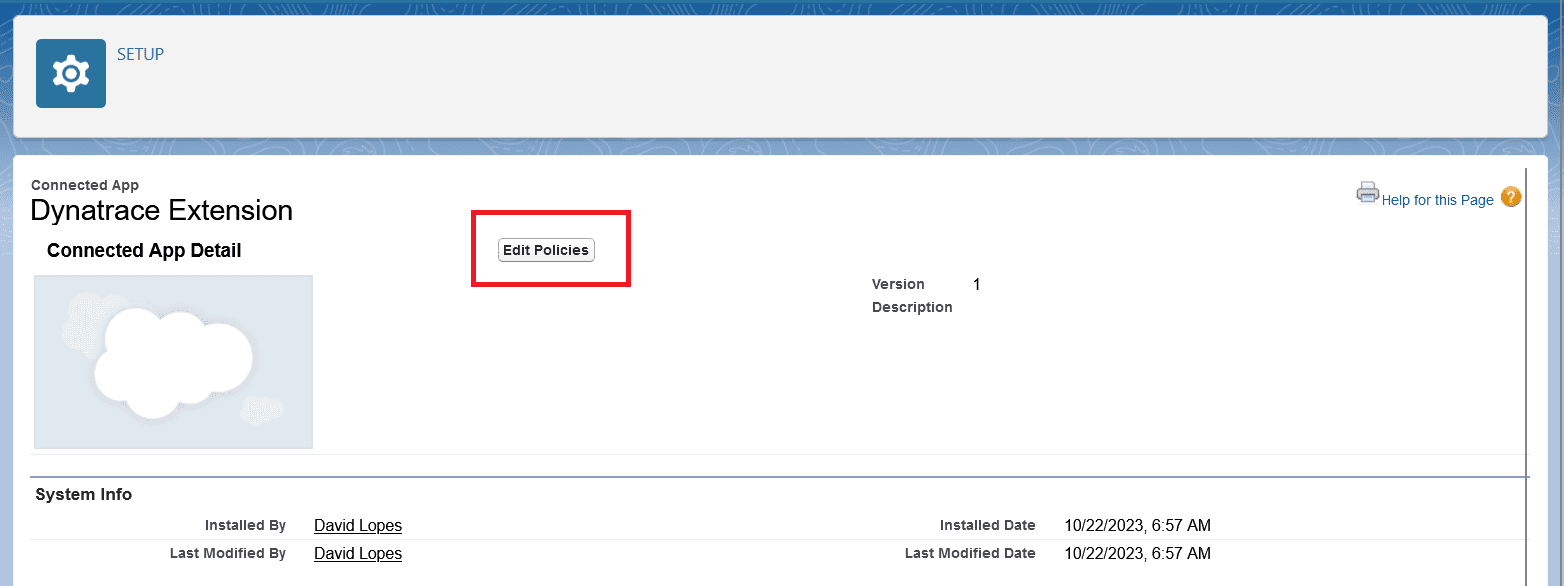
Under OAuth Policies select Admin approved users are pre-authorized.
Click Save.
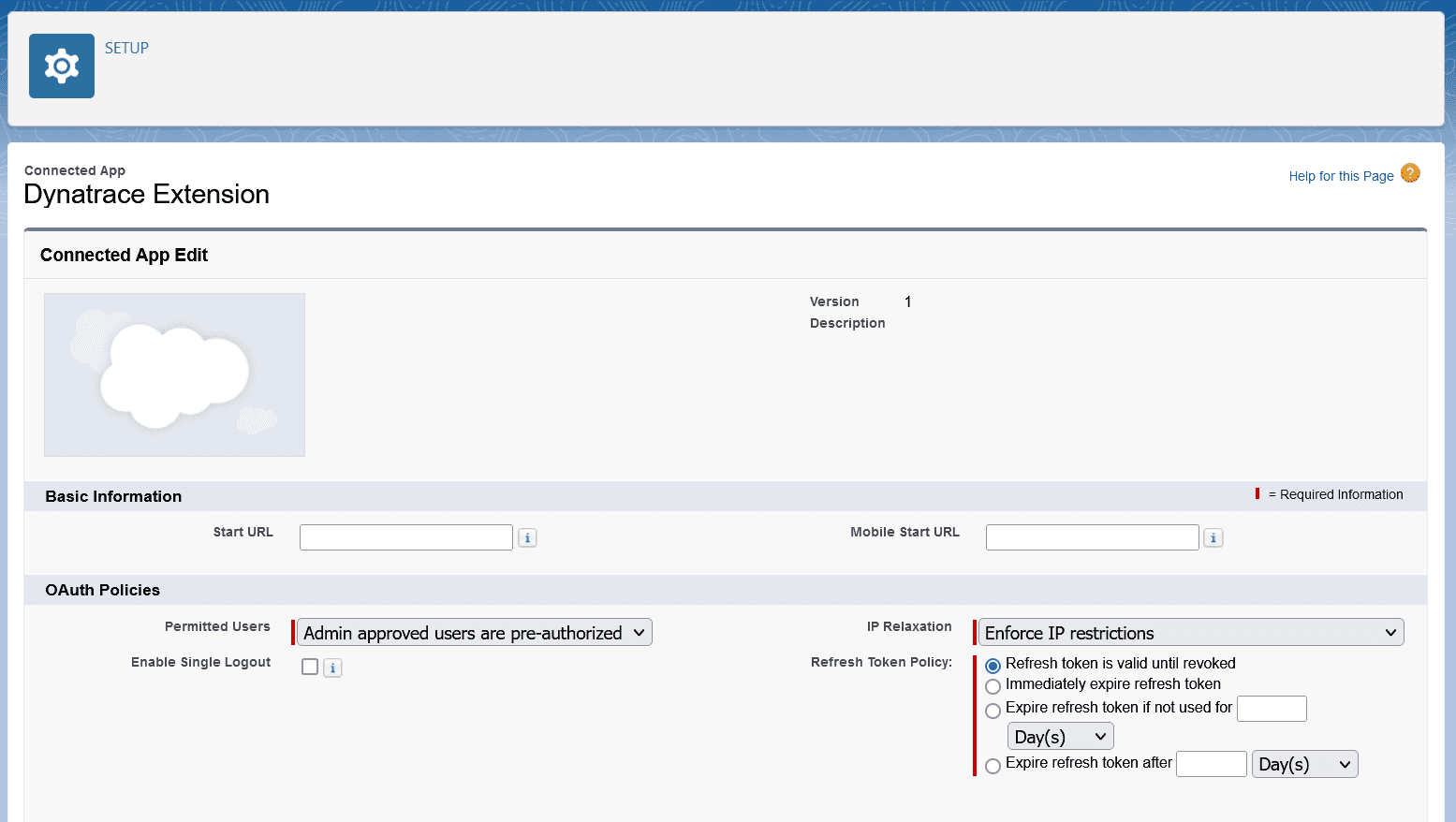
Approved users
Identify users that can use the app.
This is done by adding Profiles to the Application Profile Assignment list.
One the connected app page, under Profiles, click Manage Profiles.
Add profiles that can use the connected app.
Note: Later, any username from these profiles can be used as the Subject when configuring the extension.
Note that the profile needs the permissions:
General User Permissions
View Real-Time Event Monitoring Data
Administrative Permissions
Customize ApplicationView All Data
Please check the needed permissions documentation here

Troubleshooting
Logs
Error logs can be obtained via Dynatrace, by navigating to the Extension page, and clicking on the Status for each Monitoring Configuration.
Detailed logs can be obtained by creating an Activegate Diagnosis

Full version history
Full version history
Version 2.2.1
- Correctly set the extension log level as configured in the UI
Full version history
Version 2.2.0
- Users can now choose to not capture PII data
- Adds an option to report the events as Business Events instead of Openkit
Full version history
- Use latest version of OpenKit framework
Full version history
Version 2.1.1
- Add the option to use port 443 instead of 7443 for the pub sub API
- Fix an issue where sometimes beacons were too large for the VDA mode
Full version history
Version 2.0.15
- More aggressively clear the cache to reduce memory footprint
Full version history
Version 2.0.14
Fixes an issue where in some installations the install directory could not be determined
Full version history
Version 2.0.13
- Fix an issue with initialization
Full version history
Version 2.0.11
- Fix an issue where the Tenant ID could not be found if Dynatrace was installed in a non-default path
Full version history
Version 2.0.10
- Add option to manually input instance URL
- Fix an issue where proxies were not using during fastcheck
- Retry the connection on different pub sub errors
Full version history
Version 2.0.7
- Build with glibc 2.17 for compatibility with linux AGs running older glibc
Full version history
Version 2.0.6
- Reduce the http client timeout from 60 to 30 seconds, to better display error messages during the fastcheck
Full version history
Version 2.0.5
- Fix an issue where sometimes the thread ID for the OpenKit beacon was higher than what is allowed, causing data to not be reported.
Full version history
No release notes